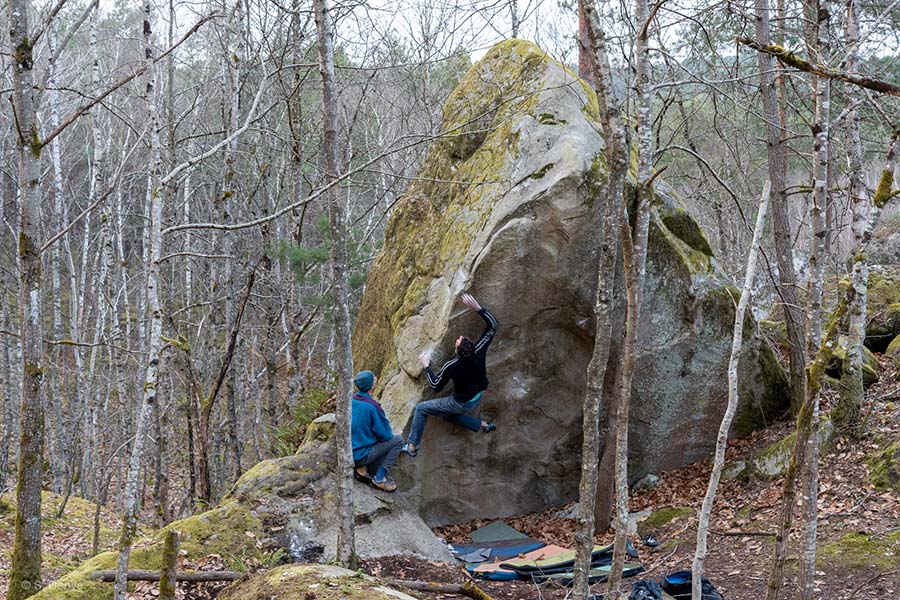Bleau.info
Ethics
The massif of Fontainebleau is a unique place, visited, traveled and highly appreciated by a variety of individuals whose uses are compatible with each other only to the extent that one activity does not negatively impact other activities. The entire sandstone massif, its trails, shelters and engravings tell the story of the rich past of those who have visited and travelled through the forest over the centuries. We climbers need to share, conserve, protect, and live in harmony with all these fragile elements that make up a unique cultural heritage.
Climbing ethics
In absence of a definition or indication, all problems start standing on the ground (doormat, rag, towel!) i.e. not on a stone or a crash pad and not with a jump start. All holds in the line of the problem may be used. In our opinion the stand start of a problem is the 'normal' version, variants as a sitstart (assis) or starting or finishing more to the left or to the right have the same name with the addition of (gauche) or (droite). We prefer not to give eliminates a seperate page and we try to avoid publishing running starts (sand on your soles polishes the rock).
Respect the environment
The Office National des Forêts (ONF) takes care of the national forest of Fontainebleau and neighbouring national forests. Most areas in the national forests are free to enter. Some parts of the forest are protected (Integral biological reserve, IBR). You can find these areas on the IGN map. Outside this national forests, areas might be on private property. They can be closed by the owners.
We all prefer to climb in an unspoiled environment. Have fun and make sure others have fun too. Please respect the boulders, the forest and other visitors. Leave no traces.
Treat the rock with respect
- Do not climb wet problems (damp sandstone is very weak). The use of fans is questionable for ethics reasons and doesn't solve the problem since the holds remain wet in depth.
- Clean your feet (sand on your soles polishes the rock).
- Brush the holds with a soft brush (many holds have been destroyed or created by vigorous brushing of (wet) rock).
- Never chip holds (despite the fact it has been done in the past).
- Use chalk sparingly and brush it off before you leave (clean sandstone has more friction and looks better).
- Do not paint arrows yourself; Cosiroc is responsible for the numbering of the circuits.
- Do not climb on boulders presenting engravings, these petroglyphs are precious and very fragile. More information here.
Treat the forest with respect
- Do not make fires (it is forbidden and very dangerous). Smoking in the forest is strictly forbidden between April 1st and October 31st.
- Do not sleep in the forest (there is a parking ban in all car parks from 22:00 to 06:00, the fine is €1500).
- Do not climb at night (it disturbs animals), all car parks are closed from 22:00 to 06:00.
- Do not damage vegetation (use existing paths as much as possible and don't drag your crash-pad, carry it).
- Use the toilet before you go climbing (if you really need to, find a place others don’t and bury your toilet paper).
- Take all your rubbish home (and why not some of others as well?).
Treat other people with respect
- Do not park in front of barriers (the path behind it might be needed by rescue services).
- Park without blocking driveways (farmers and land owners might need them).
- Respect closed and private areas and do not cross fences (they are there to keep you out).
- Keep your dogs within 100 meters of you and under your direct control (they frighten wildlife and annoy other people), dogs should be leashed from April 15th until June 30th.
- Avoid screaming and do not play music (most people love a quiet forest).
- Spot your friends and other climbers patiently and do not be rude to other visitors (also hikers use the paths between the boulders and other climbers might be keen to try ‘your’ problem too).
Text in cooperation with the 5+6 and 7+8 guidebooks.
